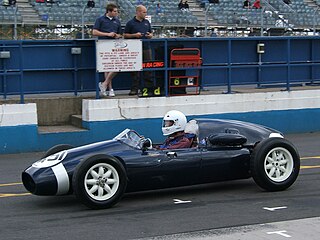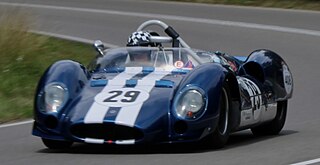
The Cooper Car Company is a British car manufacturer founded in December 1947 by Charles Cooper and his son John Cooper. Together with John's boyhood friend, Eric Brandon, they began by building racing cars in Charles's small garage in Surbiton, Surrey, England, in 1946. Through the 1950s and early 1960s they reached motor racing's highest levels as their rear-engined, single-seat cars competed in both Formula One and the Indianapolis 500, and their Mini Cooper dominated rally racing. The Cooper name lives on in the Cooper versions of the Mini production cars that are built in England, but is now owned and marketed by BMW.

Coventry Climax was a British forklift truck, fire pump, racing, and other specialty engine manufacturer.

JBW Cars was a British racing car manufacturer in the late 1950s, who were a Formula One constructor from 1959 to 1961.

Elva was a sports and racing car manufacturing company based in Bexhill, then Hastings and Rye, East Sussex, United Kingdom. The company was founded in 1955 by Frank G. Nichols. The name comes from the French phrase elle va.
Hewland is a British engineering company, founded in 1957 by Mike Hewland, which specialises in racing-car gearboxes. Hewland currently employ 130 people at their Maidenhead facility and have diversified into a variety of markets being particularly successful in electric vehicle transmission supply.

Ecurie Ecosse was a motor racing team from Edinburgh Scotland. The team was founded in November 1951 by Edinburgh businessman and racing driver David Murray and mechanic Wilkie Wilkinson, its most notable achievement was winning the 1956 and the 1957 24 Hours of Le Mans. The team also raced in three Formula One races. Ecurie Ecosse's cars were always distinctive in their Flag Blue Metallic paint.

The Cooper Mark IV was a Formula Three and Formula Two racing car designed and built by the Cooper Car Company at Surbiton, Surrey, England, in 1950.
The Mildren name was used on a series of racing vehicles constructed for, or acquired by, Australian racing team owner Alec Mildren during the 1960s and early 1970s.

The Cooper-Climax T53 is a Formula One car built by British motorsport team Cooper, in 1960. It won the Formula One World Championship that year, being driven by Jack Brabham.

The Cooper T45 was a open-wheel formula racing car, developed and built by the Cooper Car Company in 1958, and designed by Owen Maddock. It competed in Formula 2 racing as well as in Formula One racing, where it won one World Championship Grand Prix, the 1958 Monaco Grand Prix, being driven by Maurice Trintignant.

The Lola Mk1 is the first sports racing car made by Lola, under the leadership and guidance of Eric Broadley, in 1958. The body was designed and developed by chief stylist Maurice Gomm, made out of a steel or fiberglass tubular spaceframe chassis, covered in a low-profile, sleek, aluminum skin. The 80 hp (60 kW), 1,098 cc (67.0 cu in), Coventry Climax FWA four-cylinder engine was designed by Harry Mundy and Walter Hassan. The car used a 4-speed manual transmission, and was lightweight, only weighing in at a mere 812–840 lb (368–381 kg). It also notably won its class at the 1960 12 Hours of Sebring, being driven by Charles Vögele and Peter Ashdown. At least 32 cars were known to have been built, but the actual number is believed to be between 38 and 42.
The Shadow DN2, also known as the Shadow Mk.III, is a purpose-built sports prototype race car, designed, developed and built built by Shadow Racing Cars to Group 7 racing specifications, to compete in the Can-Am racing series, in 1972 and 1973. It was powered by an extremely powerful Chevrolet big-block engine, developing between 800–1,200 hp (600–890 kW), depending on boost pressure levels, and generating an asphalt-shredding 985 lb⋅ft (1,335 N⋅m) of torque The turbocharged system was used for three races, then the team switched back to a naturally aspirated engine, still producing 735 hp (548 kW); which was more than enough to get the job done.

The Osella PA3 is a Group 6 prototype racing car designed, developed, and built by Osella, to compete in the World Sportscar Championship sports car racing series in 1975, but was used in active competition through 1986. It was powered by a number of different engines, including the 2.0 L (120 cu in) BMW M12/7, the Abarth twin-cam engine, and the Cosworth BDG, or the 1.3 L (79 cu in) Cosworth BDH, or even the smaller the smaller 998 cc (60.9 cu in) Cosworth SCA. The 1.6 L (98 cu in) and 1.8 L (110 cu in) Cosworth FVA and Cosworth FVC were also used. It was even powered by a Ferrari 2.0 V8 engine.

The Cooper T39, nicknamed the "Bob-Tail", is a successful lightweight, mid-engined, sports car, designed and developed by Owen Maddock at Cooper Cars, for sports car racing in 1955. The car debuted in active racing competition at the Easter race in Thruxton in 1955, being driven by Ivor Bueb, and was later entered into the 1955 24 Hours of Le Mans, being driven by John Brown and Edgar Wadsworth, but was unfortunately not classified, because even though the car managed to complete 207 laps around the 8.4-mile Le Mans circuit, it didn't manage to finish within 70% of the winners' race distance. However, between 1956 and 1962, it did manage to rack up and tally an incredible streak of domination and competitiveness, scoring 91 total wins and clinching 236 podiums finishes; an incredible record. It was powered by the 1,098 cc (67.0 cu in) Coventry-Climax four-cylinder engine.

The Cooper-Bristol, formally called the Cooper Mk.I or the Cooper T20, is a Formula 2 racing car, built, designed, and developed by British manufacturer Cooper Cars in 1952.

The Cooper T23, formally called the Cooper Mk.II, is a Formula 2 racing car, built, designed, and developed by British manufacturer Cooper Cars in 1953. It also competed in Formula One, in 9 Grand Prix between 1953 and 1956. It was powered mainly powered by the 2-liter engine from Bristol, a six-cylinder, but also used a 2-liter Alta L-4 engine, which was used by Stirling Moss.
The Cooper-MG is a series of two MG-powered sports cars that were designed, developed and built by Cooper Cars between 1950 and 1953. They were called the Cooper T14 and the Cooper T21, respectively. They actively competed in motor racing between 1950 and 1961. In that period, the MG-powered Coopers scored a total of 23 wins and 82 podium finishes between the two cars, and 2 pole positions. They were both power by the 1,250–1,500 cc (76–92 cu in) MG XPAG engine.

The Cooper Mark III is a Formula Three open-wheel racing car designed and developed by the Cooper Car Company in Surbiton, Surrey, England, and built in 1949. It was the successor to the Mk.II, and was offered in two versions. The first option was the T7 ; which was powered by a powered by a 40 hp (30 kW) 500 cc (31 cu in) JA Prestwich Industries (JAP) 4B Speedway single-cylinder OHV motorcycle engine. The second option was the T9 ; which featured a longer chassis, with an elongated wheelbase, and used a larger and more powerful 70 hp (52 kW) 1,000 cc (61 cu in) JA Prestwich Industries (JAP) V-twin motorcycle engine. For the first time ever, a ZF limited slip differential was also offered as an optional extra for customers.

The Cooper T57 , also known as the Cooper T57 Monaco, or the Cooper Monaco T57, is a sports racing car, designed, developed and built by British manufacturer Cooper, in 1960, and was constructed as the successor model to the T49. It competed in motor racing between 1961 and 1965, and won a total of 26 races, scored 43 podium finishes, and clinched 3 pole positions. It was powered by a naturally-aspirated 2.7 L (160 cu in) Coventry Climax FPF four-cylinder engine; producing 220 hp (160 kW), and 200 lb⋅ft (270 N⋅m) of torque.

The Cooper T61 , also known as the Cooper T61 Monaco, or the Cooper Monaco T61, is a sports racing car, designed, developed and built by British manufacturer Cooper, in 1961. It is the successor and evolution of the T57. Its motor racing career spanned 6 years ; where it won a total of 16 races, achieved 23 podium finishes, and clinched 3 pole positions. It was powered by a number of different engines, including a Coventry Climax four-cylinder engine, a Maserati V8 engine, a Ford FE engine, and a Chevrolet small-block engine.















